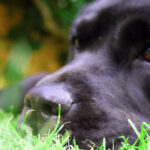Proper eye care is as important for dogs as well as humans. Left untreated, or not treated soon enough, many eye diseases and conditions can result in reduced vision or even total loss of vision. Some breeds also have genetic predispositions to various eye conditions. It is vital that your dog has a yearly eye exam by your veterinarian to catch problems early.
Healthy canine eyes will be wide open, moist, and shining. The conjunctivas (the membranes that line the eyelids) will be a healthy pink color. The pupils will constrict when exposed to bright light and dilate in dim light. There will be no accumulation of mucous or other discharges, and no swelling in and around the eyelids. A dog with irritated or damaged eyes may be squinting or blinking, pawing at his eyes or rubbing his face on the floor. He may exhibit excessive tearing, restlessness, or whimpering. Any time you notice any changes in the appearance of your dog’s eyes, discharges, redness, swelling, or cloudiness call your vet immediately.
Scratches on the cornea are common, especially in breeds with bulging eyes. Trauma from foreign objects entering the eye can result in an ulcerated cornea and keratitis, an inflammation that can lead to cloudiness of the cornea and loss of vision. If you do remove a foreign object from your dog’s eye, flush the eye with water and consult a vet. A special stain can be put into the dog’s eye to check for damage.
Conjunctivitis is an inflammation of the conjunctiva and is common to all breeds and mixed breed dogs. Symptoms include redness, squinting, and discharge from the eyes. Infections, scratches, environmental pollutants like dust or smoke can all cause conjunctivitis. The vet will usually prescribe a medicated eye ointment or drops to treat the condition.
Dogs have a third eyelid, a smooth membrane that is located between the cornea and the inside corner of the eyelid. Its purpose is to clean and lubricate the eye. The third eyelid is usually unnoticeable, but various eye conditions can cause the membrane to become inflamed and reddened. Injury, foreign objects, allergies, eye infections, protrusion of the tear duct (“cherry eye”), systemic diseases, and less common neurological conditions are all possible causes. Since it is a nonspecific symptom it requires veterinary evaluation to discover the underlying cause and necessary treatment.
Skin allergies may cause the skin around the eyes to itch. The dog may paw and rub at his eyes which become red and irritated. The allergy must be treated to relieve the problem.
The formation of cataracts is usually an inherited condition. A cataract is a cloudiness within the lens of the eye that won’t allow light to reach the retina causing partial or total loss of vision. Cataracts may only cover a small area and remain that way or they can grow quickly. Cocker Spaniels, Labrador Retrievers, Poodles, Huskies, Australian Shepherds, and Schnauzers are among the breeds with an inherited tendencey toward cataracts. Cataracts may develop in the dog at an early age or may have a late onset. Other less common causes of cataract formation include electric shock (such as from a lightning strike or chewing on an electrical cord), poor nutrition and retinal degeneration. As in humans cataracts that are causing vision loss can be surgically removed and replaced with an artificial lens. Cataract surgery can only be successful at restoring vision if the retinas are not diseased. A veterinary ophthalmologist should evaluate the condition of the retina before cataract surgery is performed.
Senior dogs may develop lenticular sclerosis which causes a cloudiness in the eye. The lens becomes hardened with age and the pupils may become a bluish-white or gray color. All geriatric dogs will develop this condition to some degree and there is no treatment. Lenticular sclerosis is not the same as a cataract and usually does not cause serious impairment of the dog’s vision until he becomes very old.
Glaucoma is an increase in pressure inside the eye caused by a build-up of fluid and can lead to partial or total blindness if not treated quickly. A change in the shape of the eyeball, redness, cloudiness, swelling, pain, excessive tearing and increased sensitivity to light are the symptoms of glaucoma. It can be inherited or result from injury. Medicine to relieve pressure inside the eye, laser surgery, or removal of the eyeball are treatment options depending upon the severity of the disease. Breeds with genetic tendencies to this condition include Basset Hounds, Cocker Spaniels and Chow Chows.
Progressive retinal atrophy (PRA) is a group of diseases that cause deterioration of the retina, the light-sensitive lining on the back of the eyeball. It has no known treatment and may happen very gradually, although some breeds may be affected early in life. Night vision is lost first followed by loss of daytime vision. The dog’s pupils will become increasingly dilated and a cataract may form in the lens. Siberian Huskies, Cocker Spaniels and Shih Tzus are most commonly affected by PRA.
Some breeds are at risk of developing eye problems because of their anatomical features. Exophthalmos is a common condition in breeds such as the Pug, Boston Terrier, Shih Tzu and Pekingese with shallow eye sockets that cause the eyes to bulge out. More of the cornea is exposed leaving it more susceptible to injury and infection. If the dog is grabbed tightly by the scruff the eyes may prolapse (pop out). This is called proptosis and is a medical emergency. Proptosis may occur in any dog through a blunt trauma accident such as being hit by a car or stuck by an object like a baseball bat. In such cases the bones of the face and jaw may also be fractured.
Entropion is a body conformation in breeds that have excessive folds of skin around the eyes. The edge of the eyelids may roll inward so that the hair and eyelashes rub across the cornea causing chronic irritation. The condition is usually apparent by six months of age and may affect the upper or lower eyelid, or both, or one or both eyes. The condition can be corrected by cosmetic surgery to remove excess skin and muscle from the eye area. Entropion can occur in most breeds but most commonly affects Pugs, Bulldogs, Rottweilers, Chow Chows, Shar-Pei, Boxers, Springer Spaniels, Poodles, Great Danes, and Saint Bernards.
Keratoconjunctivitis, or dry eye, is a caused by a deficiency in the production of tears which can result in corneal irritation and ulceration, scarring and eventually blindness if untreated. It can appear in one or both eyes. The dog will rub his eyes, squint and exhibit a sensitivity to light. The eyes may be reddened and have a thick mucous discharge. The condition is not curable but can be managed with artificial tears to make the dog more comfortable and avoid damage to the eyes. Breeds predisposed to keratoconjunctivitis include the Pekingese, Pug, Lhasa Apso, Yorkshire Terrier, Bloodhound, Boston Terrier, Miniature Poodle, Miniature and Standard Schnauzers, English Bulldog and Cocker Spaniel.
There are many other congenital, genetic and systemic causes of eye conditions and diseases in dogs. Your dog should have a yearly check-up that includes a thorough eye exam. Breeds with known inheritable eye conditions should have an eye exam in puppyhood to catch potential problems early. Some eye diseases are not preventable or treatable, but a dog with vision loss can do very well in a familiar environment. A caring owner should keep his vision-impaired dog’s surroundings as unchanged as possible. Don’t rearrange furniture in the house if you can avoid it. In an unfamiliar environment keep him on a short leash and never leave him unsupervised outdoors.
Before buying a puppy research the potentially inherited eye problems common to that breed. The Canine Eye Registry Foundation (CERF) was established to track inheritable eye conditions. Dogs with a permanent ID (tattoo or microchip) may be registered in their database as unaffected by genetic eye disease. An annual exam is required to remain certified, and dogs as young as eight weeks may be added to the registry. Ask if the puppy’s parents have been certified and registered with CERF as being free of eye disease. Dogs with eye conditions that may be genetic should not be bred.
Although genetic tendencies toward eye diseases and condition cannot be controlled there are steps you can take to keep your dog’s eyes as healthy as possible. Never allow your dog to ride with his head out of the window of a vehicle or in the back of a pick-up unless he is wearing well-fitting dog goggles (Doggles) to keep dirt, insects and other debris from flying into his eyes. Don’t use sticks or pointed objects as toys. Keep your dog out of the room when using chemical sprays such as insecticides or cleaners. Take him to the vet right away if you notice any signs of discharge, excessive tearing, redness or other abnormalities, or if he is showing any signs of pain or discomfort.





